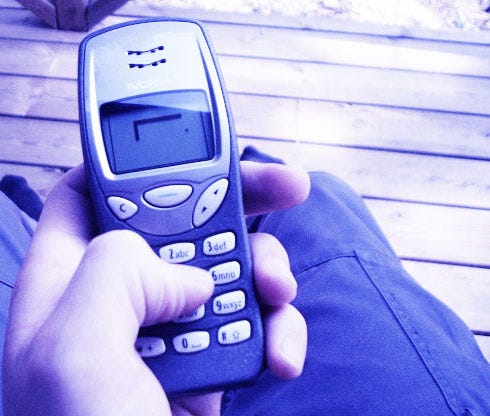

This post sketches out some thoughts about the mobile phone in history. I'm currently crowdfunding a book about mobile games, and there are just three days to get it over the threshold. Please support it here: igg.me/at/mobile-history

Promotional images of the Nokia 3210, launched in 1999, show a gracefully curved handset floating in an empty space. The header image for this post has a grey handset tilted as if looking to the right, as a row of multi-coloured models fly through the air before it.
Every phone in this image displays the start-up screen — The Nokia logo beneath an image of an adult hand reaching out to grasp the open hand of a child, against a simple gradient background that looks to me like a rolling horizon.
In other promotional images, a single handset floats mid-air, sometimes with a ‘spotlight’ background gradient, tilted slightly toward the viewer, ready for you to reach out and grab it from the ether.
The word ‘iconic’ is overused, and the cultural exchanges that go into making an object or image into an icon are complex and beyond the scope of a single blog post. I can only start sketching out here why the 3210 is a powerful image, and what it might represent.
Jon Agar describes the 3210 in his book Constant Touch, explaining how it represents a whole host of contemporary historical developments around mobility and consumer culture and individualism:
In one sense the 3210 did for mobile phones what the Model T Ford did for the automobile: it was a cheap, but beautifully engineered, vehicle for mass communication. But if the Model T Ford symbolised the dominant style of production of much of the twentieth-century, the Nokia 3210 represented its opposite. Fordism stood for centralised control, heirarchical management and, famously of the Model T, ‘any colour, as long as it’s black.’ Nokia boasted flexibility of production, flat heirarchies, and products that reflected this organisational style. With the Nokia 3210, you could change colour simply by choosing a new ‘Express-On’ facia.
Constant Touch is a really excellent introduction to the history of the mobile phone, and one of the things it does particularly well is describe the strange push and pull of globalisation through the phone as a product and a producer of change. Even to this day, mobile phone cultures are highly localised, despite the mobile phone’s significance for global connectivity. The iPhone brought a lot of disparate cultures onto one platform, but any publisher of mobile games will tell you that user behaviours and commercial structures still vary dramatically between Europe and America, between Southeast Asia and Japan, etc. A lot of this has roots in how the mobile phone network was set up in different parts of the world, and the enduring legacy of Europe’s GSM network continues to be a boon to Scandinavian app developers.
By describing the 3210 as a contrast to the Model T, Agar hints at a connection between these network-level particularities within a global flow of information and goods, and the unique, individual customisability of the mobile phone. I think more generally, we could say that between the years 1998–2008, the consumption of mobile technology was established under this kind of ostensibly flat heirarchy — unlike the mobile phone’s predecessor in the state-supported, standardised, family-owned landline phone, this was an entire system constructed through personal choice and fragmented, private corporate interests.
To understand the rise of the mobile game, especially the rise of the in-game microtransaction, we have to understand this growth of a consumer culture expressed through the personal device. It is not simply that the 3210 was one of the first phones to have a game on it, and we all remember fondly playing Snake— the 3210 established the practice of mobile phone use as a highly personalised activity within an enormous, complex structure that we couldn’t possibly understand. Snake as a game could be read in that context: a single individual flailing inside a box, grasping at tiny little objects without knowing where they could have come from.
Today, mobile phone use involves a complex series of individual decisions. Everybody’s phone has its own digital fingerprint based on the apps they’ve installed and how they’ve used them. There are companies dedicated to analysing that highly personalised data for the benefit of other companies, so that they can figure out whether and how to send you a personalised message to try and entice you to give them a particular kind of attention that they’re looking for. Our ability to make choices for ourselves is used as a way to control us. Compared to that, the 3210's first step to individualisation of the mobile device through multicoloured facias is reassuringly simple.

The 3210 is beginning to be established as a nostalgic icon. French company Lekki refurbishes old hardware with a contemporary colour palette and ships it to consumers in matte white padded boxes (their range ofNintendo machines is particularly impressive). Earlier this year they were selling Nokia’s design classics, including the 3210, in ‘custom’ colour sets. The company explains that phones produced in the 1990s are “endowed with simple architecture”, and therefore live longer, though in the process of refurbishment some technical tricks have been brought in to ensure continued longevity, such as replacing the tired old original battery with a universal Li-On model.
Lekki.fr no longer sell these attractively repainted 3210s however, and that might be because bright colours and customisability were such an essential part of the handset’s design to begin with. Unlike the Nintendo devices that come out looking freshly reimagined after Lekki’s treatment, the Nokia 3210 is simply continuing to live out its chameleonic existence.

I’m crowdfunding a book on this topic! There are just five days left to get the crowdfund over the threshold for success, so please, please back it on indiegogo
Read more about:
Featured BlogsAbout the Author(s)
You May Also Like








.jpeg?width=700&auto=webp&quality=80&disable=upscale)








